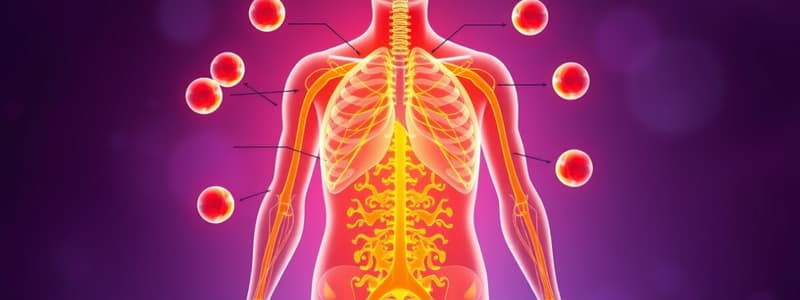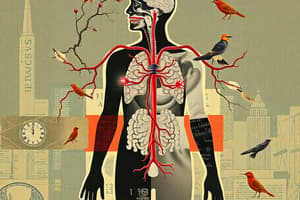Podcast
Questions and Answers
What is the primary function of the thyroid gland?
What is the primary function of the thyroid gland?
- Regulating sugar levels in the blood
- Managing blood pressure
- Regulating immune system response
- Controlling the body's metabolism (correct)
Which gland produces hormones that are essential for the fight-or-flight response?
Which gland produces hormones that are essential for the fight-or-flight response?
- Pituitary gland
- Adrenal gland (correct)
- Thymus gland
- Thyroid gland
What role does the hypothalamus play in the endocrine system?
What role does the hypothalamus play in the endocrine system?
- Regulating hormone production through the pituitary gland (correct)
- Transporting sperm through the reproductive tract
- Maintaining calcium levels in the blood
- Producing white blood cells
Which structure is responsible for the release of the mature egg during ovulation?
Which structure is responsible for the release of the mature egg during ovulation?
How does the endocrine system maintain homeostasis?
How does the endocrine system maintain homeostasis?
What is the immediate pathway taken by sperm after entering the female reproductive system?
What is the immediate pathway taken by sperm after entering the female reproductive system?
What triggers the release of a hormone's function after binding to its receptor?
What triggers the release of a hormone's function after binding to its receptor?
What are the seven dimensions of wellness?
What are the seven dimensions of wellness?
Which of the following activities can help achieve optimal health?
Which of the following activities can help achieve optimal health?
What is the role of phloem in plants?
What is the role of phloem in plants?
Which part of the flower is involved in attracting pollinators?
Which part of the flower is involved in attracting pollinators?
Which of the following is a characteristic of complete flowers?
Which of the following is a characteristic of complete flowers?
What is the primary function of stomata in plant leaves?
What is the primary function of stomata in plant leaves?
What distinguishes angiosperms from other plant groups?
What distinguishes angiosperms from other plant groups?
Which structure of the plant plays a crucial role in photosynthesis?
Which structure of the plant plays a crucial role in photosynthesis?
How do guard cells function in the context of leaf physiology?
How do guard cells function in the context of leaf physiology?
Which organ is NOT part of the male reproductive system?
Which organ is NOT part of the male reproductive system?
What type of immunity is present from birth?
What type of immunity is present from birth?
Which of the following is a characteristic of communicable diseases?
Which of the following is a characteristic of communicable diseases?
What is the primary role of a vaccine?
What is the primary role of a vaccine?
What defines noncommunicable diseases?
What defines noncommunicable diseases?
Which of the following terms refers to agents that kill most microbes on living tissue?
Which of the following terms refers to agents that kill most microbes on living tissue?
Which type of immune response focuses on combating new infections?
Which type of immune response focuses on combating new infections?
What does immune tolerance help prevent?
What does immune tolerance help prevent?
What is the main purpose of sanitation in public health?
What is the main purpose of sanitation in public health?
Flashcards are hidden until you start studying
Study Notes
Endocrine System
- Consists of glands that produce hormones necessary for bodily functions like metabolism, sleep, and temperature regulation.
- Maintains homeostasis through intricate connections among various glands.
- Hypothalamus regulates hormone production via the pituitary gland.
- Thyroid gland manages metabolism; parathyroid regulates blood calcium levels.
- Thymus produces white blood cells, crucial for immunity; adrenal gland releases adrenaline for the fight-or-flight response.
- Pancreas produces insulin to regulate blood sugar levels.
Reproductive System
- Male gamete (sperm) travels through the female reproductive tract to find the ovum (egg).
- Sperm enters through the vagina, moves to the uterus, and reaches the fallopian tubes where fertilization typically occurs.
- Ovaries produce eggs within ovarian follicles, with ovulation releasing a mature egg into the fallopian tube.
- The vagina serves as the birth canal during childbirth.
Immune System
- Comprises organs, cells, and tissues that provide defense against infections and disorders.
- Edward Jenner is recognized as the "Father of Immunology" for developing the smallpox vaccine, initiating vaccination.
- The immune system includes tonsils, thymus, spleen, lymph nodes, bone marrow, and skin.
- Innate immunity is the body's first defense, while adaptive immunity is developed after exposure to antigens.
- Immune tolerance prevents the immune system from targeting the body's own cells.
Diseases
- Diseases disrupt normal bodily functions and are identifiable through signs and symptoms.
- Classified into communicable diseases (e.g., HIV/AIDS, tuberculosis) and noncommunicable diseases (e.g., cardiovascular diseases, diabetes).
- Communicable diseases can spread through direct contact or vectors, while noncommunicable diseases stem from lifestyle and genetic factors.
Disease Prevention and Control
- Vaccines stimulate the immune system against diseases by exposing it to weakened pathogens.
- Antiseptics, disinfectants, and sterilants reduce pathogen spread; vectors like insects must be controlled to maintain health.
- Sanitation practices ensure public health by filtering water and managing waste.
Health and Wellness
- Health encompasses mental, physical, and social well-being, with wellness being the active pursuit of optimal health.
- Seven dimensions of wellness: physical, emotional, environmental, social, spiritual, intellectual, and occupational.
- Lifestyle changes such as regular exercise, a balanced diet, and meditation contribute to improved health.
Late Adulthood
- Late adulthood begins at age 65 and varies based on individual life spans influenced by genetics, diet, and lifestyle choices.
Botany and Photosynthesis
- Leaves are the primary sites for photosynthesis, featuring structures like cuticle, upper epidermis, palisade layer, spongy layer, and lower epidermis.
- Stomata enable gas exchange; guard cells control their opening to minimize water loss.
Plant Structures
- Roots anchor plants and absorb water/nutrients, with taproot and fibrous systems facilitating these functions.
- Stems transport nutrients and support plant structure, contributing significantly to the plant's overall function.
Flower Structure
- Flowers, reproductive structures of angiosperms, contain four whorls: calyx, corolla, androecium, and gynoecium.
- Pollination occurs when pollen lands on the stigma, leading to seed formation under favorable conditions.
Plant Responses: Tropism
- Tropism is an involuntary growth response toward (positive) or away (negative) from a stimulus.
- Different tropisms include gravitropism (gravity), phototropism (light), hydrotropism (water), thigmotropism (touch), and chemotropism (chemicals).
- Auxin regulates plant growth responses, influencing how plants react to stimuli.
Studying That Suits You
Use AI to generate personalized quizzes and flashcards to suit your learning preferences.




